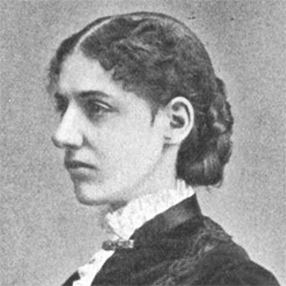A Prayer in Signs
No uttered word is ours—no solemn tone
The reverent air bears upward to the sky:
No eloquence of meaning, borne along
Of voice and accent, meet the God on high.
But dare ye tell us that we do not pray—
We who so truly “lift up hands of prayer,”
And by the speaking gesture mark the way,
Our heart’s desire would take to reach Him there?
“Our Father!” that appealing gesture lifts.
With force more potent than the spoken word,
Desire, petition for the precious gift
Held in the hand of One All-Seeing Lord.
“In Heaven!” we picture in the circling sweep
Of arm and hand, the glorious dome above;
“Holy Thy Name!” with reverent movement keep
The sacred thought of purity and love.
“Thy Kingdom!” with imperial touch we show.
The badge of royalty—the sceptre’s sway;
And that Thy glorious Will may work and grow
Potent and perfect, this and every day.
Our opened hands with daily bread to fill
The Lord we ask, “Forgive as we forgive”:
O hearing brothers! We are like you still—
The hardest this to pray, and this to live.
From tempter’s touch, whene’er beside he stands—
We pray Thee still our weakness to defend:
And by the symbol strong of broken bands
We crave deliverance, succor, to the end.
Once more the royal sign—“Thy Kingdom Thine!”
“The Power,” that sign is vital, living, strong:
“The Glory”: rays of brightness seem to shine
And scintillate around us, sweet and long.
“Forever and forever!” round and round
The finger sweeps, and who shall tell us then
Expression for the prayer we have not found,
Nor join us in our glad and grand “Amen”?
This poem is in the public domain. Published in Poem-a-Day on July 2, 2023, by the Academy of American Poets.
“American Sign Language (ASL) poetry had one of its beginnings with the frequent reciting of The Lord’s Prayer in Deaf Christian churches, non-denominational chapel at Deaf schools, and on many other occasions. Renderings had become so polished that ASL speakers in the nineteenth century saw The Lord’s Prayer as the epitome of poetic beauty. When oralists demanded the banning of ASL in Deaf schools in favor of teaching Deaf children English speech and lip-reading only, defenders of ASL often performed the Lord’s Prayer during debates to demonstrate what ASL could do. But oralism still came to dominate education, and one result is that an ever-increasing number of Deaf children, continuing even to this day, do not learn ASL until later in life. Alice Cornelia Jennings was one such child, ‘educated by the pure oral method,’ as she wrote in a 1906 issue of The Silent Worker, a national newspaper that was popular among the Deaf population of the United States at the turn of the twentieth century, ‘and, up to a few years ago, prejudiced against the use of any other.’ However, ‘experience and observation’ had changed her mind. ‘A Prayer in Signs’ is her brilliant account of The Lord’s Prayer in ASL as both performance and experience. ‘Others,’ Jennings insisted, ‘should not condemn a thing the utility and beauty of which they do not at all understand.’”
—John Lee Clark

